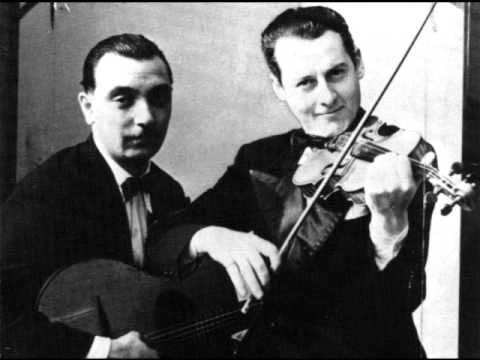Spotlight on Gypsy Jazz Guitar
Most people think of jazz as a quintessentially American genre of music. Within the jazz world, though, gypsy jazz sits as an important piece of the picture that can be traced to gypsy musicians in Western Europe. Its style builds around the gypsy jazz guitar and violin, and through its stages of development has retained a melodic, flowing style, and a focus on gypsy jazz guitar as both the lead instrument and the rhythmic engine. And while many musical styles come from several pioneers, gypsy jazz guitar indisputably comes through one specific source.
Emergence of Django Reinhardt

Django Reinhardt, born in Belgium in 1910, pioneered this style in France with violinist Stephane Grapelli and their string jazz quintet The Quintet du Hot Club de France. The feel of the music, exemplified in work like "Minor Swing" and "Nuages," is deft but smooth, pushing a swing rhythm while feeling pulled back. He used the bend and the glissando for tone and effect that were years ahead of his time. And he did it all with a left hand injury that left his ring finger and pinky mostly useless to him while he played.
For many, the acoustic guitar and steel strings Django used remain essential to the sound. With the exception of one electric guitar detour when he performed with Duke Ellington, Django used only Selmer acoustic guitars with steel strings. Many musicians looking to imitate or replicate his style begin by working with the same kind of instrument.
Important Musicians
Most directly, Django's legacy has moved through his lineage. His son Babik Reinhardt (playing "Autumn Leaves" here) and his grandson David Reinhardt (here playing "Four on Six") have continued elements of Django's sound while adding in modern elements and some different instrumentation. Both continued with a generally faithful presentation of gypsy jazz guitar style, though with a little less of the innovative flair and range of their predecessor.
ArtistWorks guitar teacher Martin Taylor has an intimate knowledge of gypsy jazz guitar, since he used to tour with Djanjo's fiddle player Stephane Grapelli for many years as his guitarist. Here's the two of them playing together in California around the year 1980:

Other gypsy jazz performers have faced the challenge of both continuing and evolving the music's origins. Angelo Debarre hews closely to the original style, though he lets his tones ring a bit more than you typically hear from a Django solo, as heard here on "Melancholy Baby." Listening to the Gonzalo Bergara Quartet on "Nightmare #2," you will see classic all-string gypsy instrumentation with techniques that move between Django's bending melodic runs and a strumming and slapping section that feel very different from what one might expect.
As a comparision, try listening to Stochelo Rosenberg play "For Sephora, you hear many of the technical stylistic elements infused with a heavier blues element to the music.
Still, one element that has changed little over the years is the swing feel. While America has evolved through styles of jazz that include swing, bop, cool, free, etc., gypsy jazz guitar still retains a swing style as essential to its overall feel and style. Even with drums added, the guitar remains the driving rhythmic force.
Current Differences
Gypsy jazz music has a place in almost every city in the United States and Europe, there are "Hot Clubs" all over if you do a quick search (like this one in San Franciso).
With all its expansion and growth, some elements are bound to shift over time. Two primary changes that gypsy jazz has experienced over the years are an expansion into more instruments and a growth among players without gypsy backgrounds.
As an example, here's ArtistWorks cello teacher Mike Block playing a great swinging version of Django's classic "Minor Swing" along with fellow cellist Rushad Eggleston and violinist Jeremy Kittel. Even without a guitar they're able to capture the same gypsy jazz essence, while at the same time adding their own personality to the music.
John Etheridge is another example of someone who combines gypsy jazz guitar with a rock fusion that creates a different sound from the more traditional hot club music. The result, in a piece like "Blue Drag," is a sound that evokes gypsy jazz more than it exemplifies it. Still, swing rhythms and bending, dancing guitar runs continue to nod in Django's direction even as the music grows and blends other elements of performers' musical backgrounds and education.
There's a lot of musicians today paying tribute to the gypsy jazz guitar, and each player has their own way of doing it. Here's ArtistWorks guitar teacher Andreas Oberg with Gonzolo Bergara playing "Coquette" and you can see some similarities and differences among them:
It's interesting to see how music that was once so connected to both its pioneer and his gypsy heritage has grown in scope and breadth. Purists may still prefer the more classic style, and that's perfectly fine. But just as other musicians in the jazz world have proved, gypsy jazz guitarists are taking the music's origins and putting their own individuality and creativity into their own creations. The more you understand about how this music has evolved, the more you have in your own arsenal to express the music within you.
For another example, here's ArtistWorks guitar teachers Martin Taylor and Bryan Sutton giving tribute to the gypsy jazz style in this tune they call "Napa Swing":
We encourage you to spend some time exploring this great guitar style. At ArtistWorks we offer online guitar lessons with many great teachers including Martin Taylor, Byran Sutton, Andreas Oberg, and more. Click below to learn more about all our different guitar teachers!
Related Blogs:








Comments